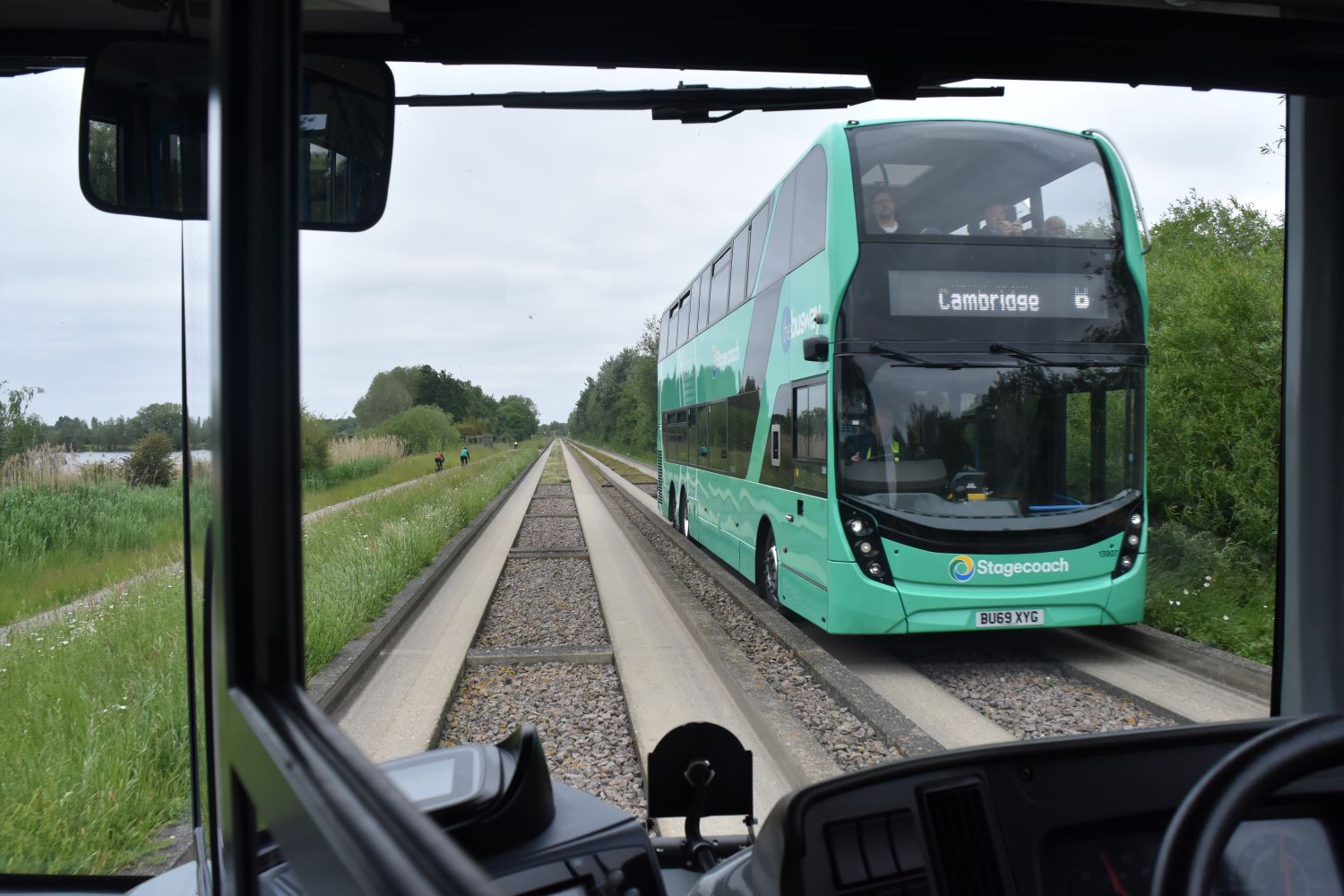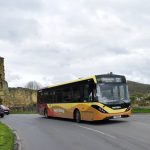routeone visited the Busway in Cambridgeshire to see how pioneering technology from Volvo is having a positive impact on public safety
The world’s longest guided busway has another superlative to its name after operator Stagecoach East teamed up with Volvo earlier this year to unveil a world-first in bus safety.
In April, Stagecoach East introduced intelligent speed assistance (ISA) technology to limit vehicle speeds on the Cambridgeshire Guided Busway. It is the first system in the world to automatically limit vehicle speed via the retarder on a guided busway. Last autumn, it earned Stagecoach East an award for Best Use of Technology (up to 150 vehicles) at the routeone awards.
Routeone received a demonstration of the technology on part of the busway, 16 miles of which in two sections is guided. Fenstanton depot Operations Manager Danny Smith took me on a ride from St Ives Park and Ride towards Cambridge to show the system in action.
Eighteen months of testing
Danny was involved from the outset in the roll-out, which took 18 months of painstaking work before it was used on operated services. Many of us are familiar with car satnav devices that use Google’s data to inform us of the speed limit, but this is not always accurate.
The software designed by Volvo required Danny to input the limit for every part of the route. This involved “drawing” a zone along the segment in question and selecting the speed limit which is enforced by the physical signs on the busway.
Ensuring the placement of the zones was spot-on took much trial and error, given that the speed reduction would need to be applied well before the sign. He would sometimes travel nearly 200 miles per day with the representative from Volvo, often needing to go over each section several times.
The highest maximum speed on the Busway is 50mph, which when you’re standing next to the driver at the front of the bus on your first ride on a busway is a slightly disconcerting experience at first.
That is until you learn to trust the fact that the wheels aren’t going to veer off the very narrow channels into the ditch in the middle due to the fact they are being controlled by guide-wheels rather than the driver, who only needs to steer the bus when entering and exiting these sections.
Technology is a back-up
The system is impressive when seen in action. Braking is gradual and efficient when the bus’s GPS detects it is about to enter a reduced speed zone. The driver is unable to exceed the limit, as no over-ride is possible via the accelerator. The retarder and throttle rather than braking are used as a mechanism to better ensure the vehicle is slowed down in time.
Danny stresses the ISA is just a back-up and the drivers should be taking their foot off the accelerator before the system takes over. Going through geofenced ‘gateways’ at the end of each route tells the vehicle’s software that the speed zones for the opposite direction need to be applied. The system can be monitored at the depot using Volvo Connect software so Stagecoach East can feedback any issues to the manufacturer.

The speed limits rapidly change. For example, on entry to the track, it is 20mph and, through park-and-ride stations, it is 15mph. It also slows when crossing roads with regular traffic and at many points to ensure safety for pedestrians and cyclists. The Sunday Times this year listed the Busway as one of the most scenic routes in the country and it’s not just bus users who want to make the most of it.
The Busway, which was built on the course of a disused railway line, has a path running alongside and, since its opening in 2011, this has become massively popular with walkers, runners and cyclists. A scientific study in 2016 highlighted the resulting positive effect of the Busway on health and wellbeing.
Safety is crucial
However, this has meant safety has had to be a top concern, especially as drivers are unable to steer around danger on the busway. Three deaths — between 2015 and 2022 — have occurred involving collisions between cyclists or pedestrians with buses on the route.
As a result, last month it was announced that a Health and Safety Executive prosecution was being brought against Cambridgeshire County Council, the owners of the Busway.
An independent safety audit published last year made recommendations to improve on safety. In 2019, a 30mph speed limit was applied to the whole of the busy southern section and nearly £300 million has been earmarked to widen this part of the network. But Stagecoach East hope the ISA technology will improve public safety even further.
Although pedestrians and cyclists are fewer than on a busy main road, potential hazards are frequently encountered, whether it’s a footpath on to the walkway concealed by overgrowth or a pedestrian walking along the path. Danny’s running commentary was a reminder of how safety is a top priority on a busway, just as it is on a road.
Showing the way forward?
In as much as the Busway itself has been pioneering in many ways, Stagecoach East could be showing the way forward for road safety. The operator says it hopes the technology can be rolled out to other operations in the future.
 Busway a ‘success’
Busway a ‘success’
The Cambridgeshire Guided Busway, operated by Stagecoach and Whippet, has been dogged by controversy: Its completion went over-budget, there were alleged ongoing costly defects and Busway owner Cambridge City Council (CCC) is being prosecuted by the Health and Safety Executive over three deaths.
However, 12 years on from its opening, CCC is pleased with patronage despite the universally experienced pandemic-related downturn. A council spokesperson says: “Since the opening of the Guided Busway in August 2011 there have been millions of passenger journeys. The number of services has increased in the 10-plus years since opening — as has the frequency of the buses.”
The council cites a 37% decrease in the passenger numbers in both January and February 2023 versus the equivalent pre-pandemic, with more than 223,000 travelling in January of this year.
However, the success or failure of the busway is down to more than passenger numbers, the council believes. The spokesperson adds: “We know the main reasons the public use the busway are speed, reliability and frequency, so we’re pleased with the success of the busway since it opened.
“We also know that many people use the cycle, pedestrian and bridleway track next to the Busway, which has its own health benefits, encouraging walking, running and cycling.”
The Busway is seen to tie into the ambitious plans of the Greater Cambridge Partnership and Cambridgeshire & Peterborough Combined Authority to improve bus services in the area.
The statement continues: “Our joint administration has been clear, in Cambridgeshire. The aim is to make buses, and active travel the ‘go-to’ options for local journeys, which will not only improve people’s health and provide another travel option for people not able to travel by car, but will also help the council reach its ambitious target of the county becoming carbon net-zero by 2045.”
“Public transport is a key solution to the connectivity, climate and economic challenges that the country faces and this is reflected in the Greater Cambridge Partnership’s programme, which seeks to introduce more busways connecting residential and employment areas in Greater Cambridge.”


























